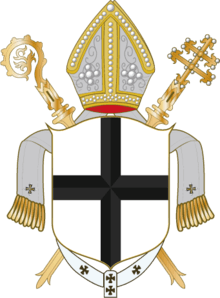Coats of arms of the Holy Roman Empire
Over its long history, the Holy Roman Empire used many different heraldic forms, representing its numerous internal divisions.
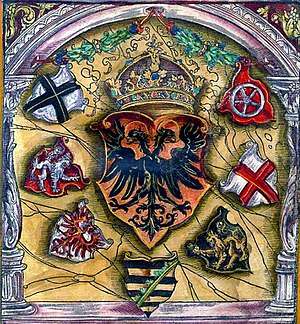
Imperial coat of arms

Coats of arms of Holy Roman Emperors
The Reichsadler ("Imperial Eagle") was the heraldic eagle, derived from the Roman eagle standard, used by the Holy Roman Emperors and in modern coats of arms of Germany, including those of the Second German Empire (1871–1918), the Weimar Republic (1919–1933) and the "Third Reich" (Nazi Germany, 1933–1945). The same design has remained in use by the Federal Republic of Germany since 1945, but under a different name, now called Bundesadler ("Union Eagle" or "Federal Eagle", from German "Bund", genitive form "Bundes" meaning 'Union' or 'Federation', and "Adler" meaning 'Eagle').
Quaternion Eagle
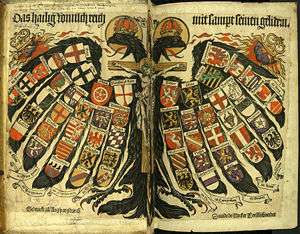
One rendition of the coat of the empire was the "Quaternion Eagle" (so named after the imperial quaternions) printed by David de Negker of Augsburg, after a 1510 woodcut by Hans Burgkmair. It showed a selection of 56 shields of various Imperial States in groups of four on the feathers of a double-headed eagle supporting, in place of a shield, Christ on the Cross. The top, larger shields, are those of the seven Prince Electors, the ecclesiastical: Trier, Cologne and Mainz as well as of the titular "Prefect of Rome" on the right wing; the secular: Bohemia, Electorate of the Palatinate, Saxony and Brandenburg on the left. The depiction also appeared on the Imperial Eagle beaker
Holy Roman Emperors
Direct attestations of imperial coats of arms become available in the later 13th century. Past emperors are given attributed arms in 13th-century sources. Thus, Otto IV is given the first known depiction of a double-headed Reichsadler in the Chronica Majora (ca. 1250). Henry VI is given a (single-headed) Reichsadler in the Codex Manesse (c. 1320).
Frederick II of Hohenstaufen (Emperor 1220–1250) did not use coats of arms in any of his seals. He did use the imperial eagle on some of his coins, but not displayed as a heraldic charge in a heraldic shield. Frederick's son and co-ruler Henry did have an equestrian seal with the Hohenstaufen coat of arms of three leopards, and this coat of arms is later attributed to Frederick II as well.
From the reign of Albert II (reigned 1438–39, was never crowned emperor), each Emperor bore the old Imperial arms (Or, an eagle displayed sable beaked and membered gules) with an inescutcheon of pretence of his personal family arms. This appears therefore as a black eagle with an escutcheon on his breast. Before 1438 the Emperors used separate personal and an imperial coat of arms. The arms of the High Offices of the Empire were borne as an augmentation to the office-holder's personal arms.
| Personal arms | Imperial arms | Name/Blazon of personal arms |
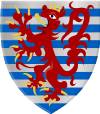 |
.svg.png) |
Barry of ten argent and azure, a lion rampant gules crowned or. |
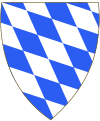 |
.svg.png) |
Fusilly bendwise argent and azure. |
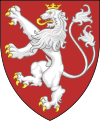 |
.svg.png) |
Gules a lion rampant argent, queue fourchée crossed in saltire, armed, langued, and crowned Or. |
 |
.svg.png) |
Per pale, dexter barry of eight, gules and argent (for Hungary); sinister gules a lion rampant argent, queue fourchée crossed in saltire, armed, langued, and crowned Or (for Bohemia). |
 |
 |
Gules a fess argent. |
 |
 |
Per pale, dexter gules a fess argent (for Austria); sinister bendy of six Or and azure, a bordure gules (for the French Duchy of Burgundy). |
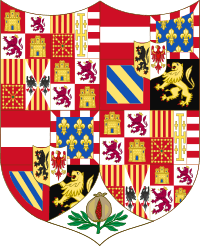 |
.svg.png) |
Quarterly: I and IV grand-quarterly i and iv great-grand-quarterly 1 and 4 gules a three towered castle Or masoned sable and ajouré azure (for Castile), 2 and 3 argent a lion rampant purpure crowned Or langued and armed gules (for Leon), ii per pale, dexter per fess, in chief Or four pallets gules (for Aragon), in base gules a cross, saltire, and orle of chains linked together Or and a centre point vert (for Navarre), sinister argent a cross potent and four crosslets Or (for Jerusalem) impaling barry of eight gules and argent (for Hungary), iii per pale, dexter per fess, in chief Or four pallets gules (for Aragon), in base gules a cross, saltire, and orle of chains linked together Or and a centre point vert (for Navarre), sinister per saltire, 1 and 4 Or four pallets gules, 2 and 3 argent an eagle displayed sable (for Sicily); II and III grand-quarterly, i gules a fess argent (for Austria), ii azure semy-de-lis Or a bordure compony argent and gules (new Burgundy), iii bendy of six Or and azure a bordure gules (old Burgundy), iv sable a lion rampant Or langued and armed gules (for Brabant), overall at the fess point of the quarter an inescutcheon Or a lion rampant sable armed and langued gules (for Flanders) impaling argent an eagle displayed gules, armed, beaked, and langued Or (for Tyrol); enté en point argent a pomegranate proper seeded gules, supported, sculpted and slipped vert (for Granada). |
 |
.svg.png) |
Quarterly, I and IV gules a lion rampant argent, queue fourchée crossed in saltire, armed, langued, and crowned Or (for Bohemia); II and III barry of eight, gules and argent (for Hungary); overall and inescutcheon per pale, dexter gules a fess argent (for Austria), sinister bendy of six Or and azure, a bordure gules (for Burgundy). |
 |
.svg.png) |
Quarterly, I gules a lion rampant argent, queue fourchée crossed in saltire, armed, langued, and crowned Or (for Bohemia); II barry of eight, gules and argent (for Hungary); III per pale, dexter gules a fess argent (for Austria), sinister bendy of six Or and azure, a bordure gules (for Burgundy); IV grand-quarterly i and iv gules a three-towered castle Or (for Castile), ii and iii argent a lion rampant purpure armed, langued, and crowned Or (for Leon). |
 |
.svg.png) |
Quarterly, I gules a lion rampant argent, queue fourchée crossed in saltire, armed, langued, and crowned Or (for Bohemia); II barry of eight, gules and argent (for Hungary); III grand-quarterly, i and iv gules a three-towered castle Or (for Castile), ii and iii argent a lion rampant purpure armed, langued, and crowned Or (for Leon); IV per pale, dexter bendy of six Or and azure a bordure gules (for Burgundy), sinister per fess, chief argent an eagle displayed gules armed, langued, and beaked Or (for Tyrol), and base Or a lion rampant sable, armed and langued gules (for Flanders); overall an inescutcheon gules a fess argent (for Austria). |
 |
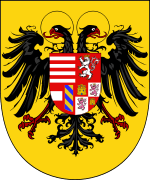 |
Quarterly, I barry of eight, gules and argent (for Hungary); II gules a lion rampant argent, queue fourchée crossed in saltire, armed, langued, and crowned Or (for Bohemia); III per pale, dexter gules a fess argent (for Austria), sinister bendy of six Or and azure, a bordure gules (for Burgundy); IV grand-quarterly i and iv gules a three-towered castle Or (for Castile), ii and iii argent a lion rampant purpure armed, langued, and crowned Or (for Leon). |
 |
 |
Quarterly, I and IV gules a lion rampant argent, queue fourchée crossed in saltire, armed, langued, and crowned Or (for Bohemia); II and III barry of eight, gules and argent (for Hungary); overall and inescutcheon per pale, dexter gules a fess argent (for Austria), sinister bendy of six Or and azure, a bordure gules (for Burgundy). |
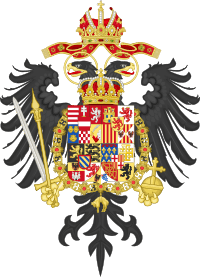 |
Quarterly, I gules a three-towered castle Or (for Castile); II barry of eight, gules and argent (for Hungary); III per pale, dexter Or four pallets gules (for Aragon), sinister per saltire i and iv Or four pallets gules, ii and iii argent an eagle displayed sable (for Sicily); IV per pale, dexter gules a fess argent (for Austria), sinister bendy of six Or and azure a bordure gules (for Burgundy); overall an inescutcheon gules a lion rampant argent, queue fourchée crossed in saltire, armed, langued, and crowned Or (for Bohemia). | |
 |
Quarterly, I and IV fusilly bendwise argent and azure (for Bavaria); II and III sable a lion rampant Or, armed, langued, and crowned gules (for the Electorate of the Palatinate); overall an inescutcheon gules an orb Or (for Arch-Steward of the Holy Roman Empire). | |
 |
Quarterly, I barry of eight gules and argent (for Hungary) impaling azure semy-de-lis Or a label gules (for Naples); II argent a cross potent and four crosslets Or (for Jerusalem) impaling Or four pallets gules (for Aragon); III azure semy-de-lis Or a bordure gules (for the House of Valois-Anjou) impaling azure a lion sinister rampant Or, armed, langued, and crowned gules (for Guelders); IV Or a lion rampant sable, armed and langued gules (for Jülich) impaling azure crusilly fitchy, two barbels haurient addorsed Or (for Bar); overall an inescutcheon Or a bend gules three alerions argent (for Lorraine) impaling Or, in annulo six torteaux, the torteau in chief replaced by a roundel azure charged with three fleurs-de-lis Or (for the Medici family). | |
 |
Quarterly, I barry of eight, gules and argent, impaling gules a patriarchal cross argent on a trimount vert (for Hungary); II gules a lion rampant argent, queue fourchée crossed in saltire, armed, langued, and crowned Or (for Bohemia); III bendy of six Or and azure, a bordure gules (for Burgundy); IV Or, in annulo six torteaux, the torteau in chief replaced by a roundel azure charged with three fleurs-de-lis Or (for the Medici family); overall and inescutcheon gules a fess argent (for Austria) impaling Or a bend gules three alerions argent (for Lorraine). | |
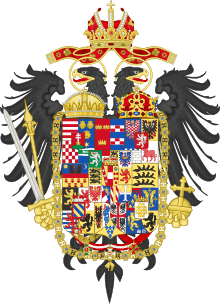 |
Quarterly, I barry of eight, gules and argent, impaling gules a patriarchal cross argent on a tri-mount vert (for Hungary); II gules a lion rampant argent, queue fourchée crossed in saltire, armed, langued, and crowned Or (for Bohemia); III bendy of six Or and azure, a bordure gules (for Burgundy); IV azure crusilly fitchy, two barbels haurient addorsed Or (for Bar); overall an inescutcheon per pale, dexter Or a bend gules three alerions argent (for Lorraine), sinister Or, in annulo six torteaux, the torteau in chief replaced by a roundel azure charged with three fleurs-de-lis Or (for the Medici family), overall on a pale gules a fess argent (for Austria). | |
High offices (Reichserzämter)
Prince-electors
The seven Electors named in the Golden Bull of 1356 were: the Prince-Bishops of Cologne, Mainz and Trier, the King of Bohemia, the Count Palatine of the Rhine, the Duke of Saxony and the Margrave of Brandenburg.
The Count Palatine was replaced by the Duke of Bavaria in 1623, as the Elector Palatine, Frederick V, came under the imperial ban after participating in the Bohemian Revolt. The Count Palatine was granted a new electorate in 1648. Saxony was held by a Protestant elector from 1525 (John), the Palatinate from 1541 (Otto Henry). In 1685, a Catholic branch of the Wittelsbach family inherited the Palatinate and a new Protestant electorate was created in 1692 for the Duke of Brunswick-Lüneburg, who became known as the Elector of Hanover (officially confirmed by the Imperial Diet in 1708). The Elector of Saxony (Augustus II) converted to Catholicism in 1697 so that he could become King of Poland, but no additional Protestant electors were created, and the Electorate itself remained officially Protestant.
Secular Electors
| Arms | Electorate/Blazon |
 |
Bohemia
Gules a lion rampant argent, queue fourchée crossed in saltire, armed, langued, and crowned Or.[3] |
.svg.png) .svg.png) |
Electorate of the Palatinate (suspended 1623–1648)
|
 |
Brandenburg
Argent an eagle displayed gules crowned Or. |
 |
Saxony |
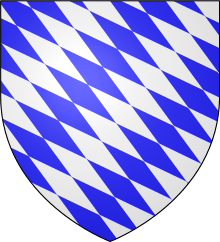 |
Bavaria (from 1623) |
 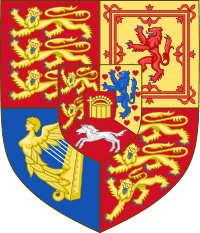 |
Brunswick-Lüneburg (Hanover) (from 1692)
Per pale, I Gules two lions passant guardant Or (for Brunswick), II Or a semy of hearts Gules a lion rampant Azure (for Lüneburg).
|
Other states
Entries are listed by Imperial Circle (introduced 1500, 1512) even for territories that ceased to exist prior to 1500.
Austrian Circle
| Arms | Location/Blazon |
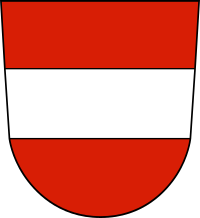 |
Archduchy of Austria |
 |
Duchy of Carinthia
Or three lions passant sable armed and langued gules impaling gules a fess argent. |
 |
Duchy of Carniola
Argent an eagle displayed azure, armed, beaked, and langued gules, charged with a crescent chequy gules and Or. |
 |
Patria del Friuli
Azure an eagle displayed Or. |
 |
Duchy of Styria
Vert, a panther rampant argent incensed proper. |
 |
County of Tyrol
Argent an eagle displayed gules, armed, beaked, and langued Or. |
Bavarian Circle
| Arms | Location and blazon |
|---|---|
 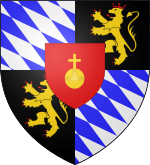 |
Bavaria
|
 |
Haag
Gules, a horse springing argent, bridled argent. |
| Leuchtenberg
Quarterly: I and IV gules, an oak branch with acorns Or; II and III Or, a hops branch vert; an inescutcheon argent a fess azure. | |
 |
Ortenburg
Gules, a bend embattled-counter-embattled argent |
 |
Prince-bishopric of Passau
Argent a wolf gules |
 |
Prince-bishopric of Regensburg
Gules, two keys in saltire argent. |
 |
Prince-archbishopric of Salzburg
Party per pale: Or a lion rampant sable, armed and langued gules; and gules a fess argent. |
Burgundian Circle
| Arms | Location/Blazon |
.svg.png)  |
County of Burgundy
|
 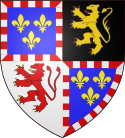 |
Brabant
|
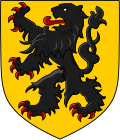 |
Flanders
Or a lion rampant sable. |
.svg.png) 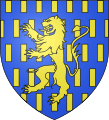 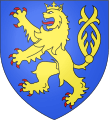 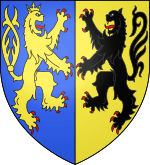 |
Guelders
|
 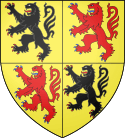 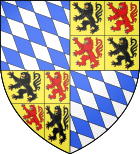 |
County of Hainaut
|
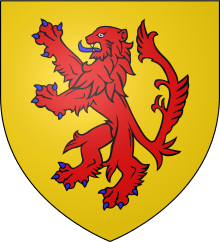 |
Holland
Or a lion rampant gules, armed and langued azure. |
 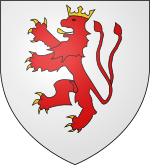 |
Duchy of Limburg
|
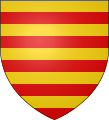     |
County of Loon (County of Chiny)
|
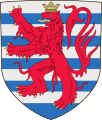 |
Duchy of Luxembourg
|
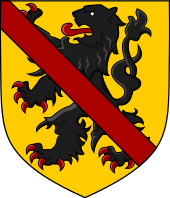 |
County of Namur
Or, a lion rampant sable, armed and langued gules, a bend overall of the same. |
Franconian Circle
| Arms | Location and blazon |
|---|---|
 |
Prince-bishopric of Bamberg
Or, a lion rampant armed and langued gules, overall a ribband argent. |
 |
County of Castell
Quarterly, argent and gules. |
 |
County of Erbach
Party per fess gules and argent, three six-pointed mullets counterchanged. |
 |
County of Hohenlohe
Argent, two lions passant guardant sable, langued gules. |
 |
County of Löwenstein-Wertheim
Party per fess: fusily argent and azure; and Or, a lion statant gules, atop a mount azure. |
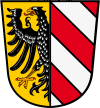 |
City of Nuremberg
Or, a double-headed eagle sable dimidiating bendy gules and argent. |
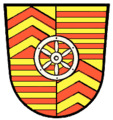 |
County of Rieneck
Quarterly: chevrony Or and gules; and barry Or and gules; overall a Wheel of Mainz argent. |
 |
Rothenburg ob der Tauber
Argent, a double-towered castle gules. |
 |
Schwarzenberg
Quarterly: paley azure and argent; Or, a raven pecking the eye out of a Turk's head couped at the neck proper. |
 |
Schweinfurt
Azure an eagle displayed argent. |
 |
Seinsheim
Argent, three pallets azure, a bend sinister wavy Or. |
 |
Weißenburg im Nordgau
Gules, a castle argent, portcullised Or, with an escutcheon of the Imperial arms (Or, a double-headed eagle sable) at the honour point. |
 |
Welzheim
Argent, a pine tree on a mount Vert. |
 |
County of Wertheim
Party per fess: Or, a demi-eagle displayed sable; and azure three roses argent. |
 |
Wiesentheid
Gules, a lion passant reversed Or, crowned Or; with three stems of grass surtout, all on a mount Vert. |
 |
Windsheim
Argent, an eagle sable, armed and langued Or, with a W Or on the breast. |
 |
Prince-bishopric of Würzburg
Argent a Celtic cross sable; a chief dancetty gules (de). |
Lower Rhenish-Westphalian Circle
| Arms | Location/Blazon |
  |
Duchy of Cleves
|
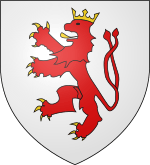 |
Berg
Argent a lion rampant gules, queue fourchée crossed in saltire, armed, langued, and crowned Or. |
 |
Duchy of Jülich
Or a lion rampant sable, armed and langued gules. |
 |
Prince-Bishopric of Liège
Quarterly: I: gules a fess argent; II: Argent, three lions rampant vert, crowned or, armed and langued gules; III: Barry gules and or; IV: Or, three hunting horns gules, hooped and belted argent. Overall an inescutcheon gules, a perron or, supported by three lions, surmounted by a pineapple and a cross pattée, with the capital letters L and G aside, all of the same. |
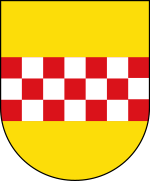  |
County of Mark
|
 |
County of Ravensberg
Argent three chevrons gules. |
Upper Rhenish Circle
| Arms | Location/Blazon |
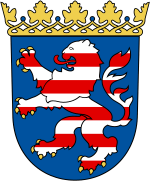 |
Landgraviate of Hesse
Azure a lion rampant barry argent and gules. |
 .svg.png)  .svg.png) |
Lorraine
|
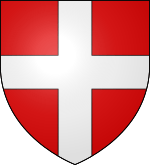 |
Duchy of Savoy
Gules a cross argent. |
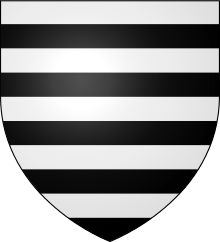 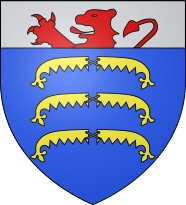 .svg.png) |
Vaudémont
|
Electoral Rhenish Circle
| Arms | Location and blazon |
|---|---|
 |
Arenberg
Gules, three estoiles Or voided; on a chief Or three torteaux. |
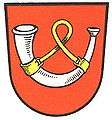 |
Beilstein
Gules, a hunting horn argent, bound Or. |
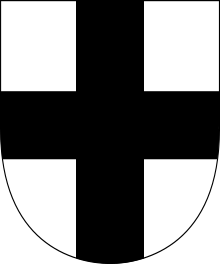 |
Prince-archbishopric of Cologne |
 |
Lower Isenburg
Argent two bars sable. |
 |
Prince-archbishopric of Mainz
Gules, a wheel argent. |
.svg.png) .svg.png) |
Electorate of the Palatinate |
 |
Thurn und Taxis
Quarterly: argent, two sceptres Or in saltire, tipped with fleurs-de-lys Or, overall a tower gules, ajouré azure; and Or a lion gules, crowned, armed and langued azure; overall an escutcheon: azure, a badger argent. |
 |
Prince-archbishopric of Trier
Argent a cross gules.[1] |
Lower Saxon Circle
| Arms | Location |
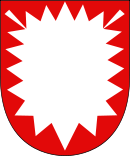 |
Holstein
Gules, a nesselblatt argent. |
Upper Saxon Circle
| Arms | Location/Blazon |
 |
Margraviate of Brandenburg
Argent an eagle displayed gules crowned Or. |
 |
Duchy of Pomerania |
 |
Duchy of Saxony |
Swabian Circle
| Arms | Location/Blazon |
 |
Augsburg |
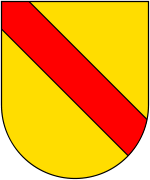 |
Baden
Or a bend gules. |
Lands of the Bohemian Crown
| Arms | Location/Blazon |
 |
Kingdom of Bohemia
Argent, a lion rampant queue forchée, armed, langued and crowned Or. |
 |
Moravia
Azure an eagle displayed chequy argent and gules, crowned Or. |
 |
Görlitz
Per fess, chief gules a lion rampant argent, armed, langued, and crowned Or; base argent. |
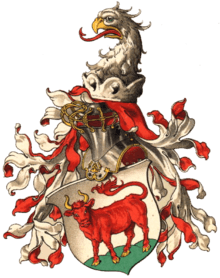  |
Lusatia
|
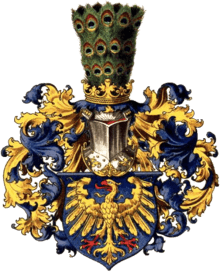 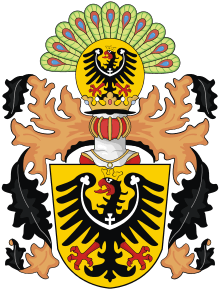 |
Silesia
|
Other
| Arms | Location/Blazon |
.svg.png) |
Geneva (before 1401)
Or a cross quarter-pierced azure. |
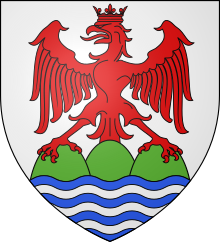 |
Nice (as part of the Duchy of Savoy from 1046)
Argent, an eagle displayed crowned gules standing upon three rocks sable issuing from the sea azure issuing from the base. |
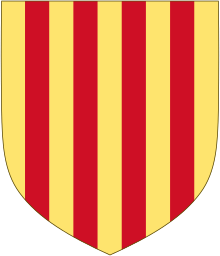  |
Provence (before 1481)
|
 |
Prussia (after 1701)
Argent, an eagle displayed sable crowned Or. |
 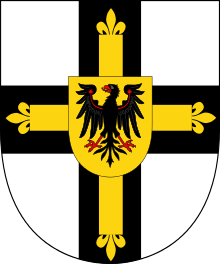 |
Teutonic Knights (1224–1525)
|
 |
Viennois (before 1349)
Or, a dolphin haurient azure finned gules. |
References
| Wikimedia Commons has media related to Scheibler Armorial. |
- "Bernhard Peter Monographien: Wappen der Bistümer". Archived from the original on 2007-11-23. Retrieved 2007-11-14.
- "Die Wappen der Landkreise". Archived from the original on 2007-11-17. Retrieved 2007-11-14.
- "Königreich Böhmen". Retrieved 2007-11-14.
- "Kultur und Geschichte". Friedelsheim in der Pfalz. Archived from the original on 2007-09-29. Retrieved 2007-11-14.





